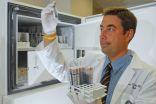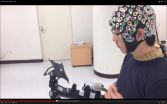(Press-News.org) This news release is available in French.
This news release is available in French.
New research shows that teaching young adolescents practical cooking skills leads to positive changes for the entire family. In an article published today in Applied Physiology, Nutrition, and Metabolism, an NRC Research Press journal (a division of Canadian Science Publishing), researchers evaluated the Kinect-Ed presentation and found an increase in the frequency of family dinners after participation.
Kinect-Ed, a 90-minute motivational nutrition education presentation, was created to encourage young adolescents (grades 6-8) to help with meal preparation and improve the frequency of family dinners. Kinect-Ed was developed by Sandi Richard, a Food Network host and Dr. Sarah Woodruff, a professor in the Department of Kinesiology at the University of Windsor. The Kinect-Ed presentation utilizes the school environment to provide interactive demonstrations that explain how consuming excess fat, sugar and salt can affect the body.
In this study, researchers from the University of Windsor found that after the Kinect-Ed presentation the frequency of family dinners increased resulting in more families eating dinner together. "This research builds on past studies that suggest that an increase in the frequency of family meals has been associated with better grades, better self-esteem and mental health and a lower likelihood of engaging in risky behaviours such as smoking and drinking," says Sara Santarossa, lead author and graduate student at the University of Windsor. "The results of our study show that introducing the Kinect-Ed program will create positive benefits, including improving the frequency of family dinners and food preparation, improving confidence in cooking, and improving food preparation techniques". An increase in family meals during adolescence is also commonly associated with healthy eating and positive eating habits into young adulthood. Until now, limited research exists in the area of cooking and family meal interventions.
As an added bonus for parents, encouraging young adolescents to help prepare meals and get involved in the kitchen may reduce the time needed from parents to prepare the meal, which in turn could allow for more time for frequent family dinners. Promoting family meals is a relatively easy and cost-effective health promotion endeavour, and developing simple interventions may lead to healthier children.
Success of the program will require partnerships from educators and school boards. Kinect-Ed is designed to be presented in the schools and will require support from school boards and educators to allow this program to reach more adolescents.
The paper "An evaluation of the Kinect-Ed presentation, a motivating nutrition and cooking intervention for young adolescents in grades 6-8" by Sara Santarossa, Jillian Ciccone, and Sarah J. Woodruff was published today in the journal Applied Physiology, Nutrition, and Metabolism.
INFORMATION:
Visit the Applied Physiology, Nutrition, and Metabolism website to read the full study.
Citation
Please cite Applied Physiology, Nutrition, and Metabolism as the source of this story and include a hyperlink to the research study: dx.doi.org/10.1139/apnm-2015-0110.
Media Contact:
Rebecca Ross, Manager, Communications, Canadian Science Publishing, rebecca.ross@cdnsciencepub.com.
Reference
"An evaluation of the Kinect-Ed presentation, a motivating nutrition and cooking intervention for young adolescents in grades 6-8" by Sara Santarossa, Jillian Ciccone, and Sarah J. Woodruff
Applied Physiology, Nutrition, and Metabolism, 2015, 10.1139/ apnm-2015-0110
About the Journal
Applied Physiology, Nutrition, and Metabolism publishes original research articles, reviews, and commentaries, focussing on the application of physiology, nutrition, and metabolism to the study of human health, physical activity, and fitness. The published research, reviews, and symposia will be of interest to exercise physiologists, physical fitness and exercise rehabilitation specialists, public health and health care professionals, as well as basic and applied physiologists, nutritionists, and biochemists.
Disclaimer
Canadian Science Publishing publishes the NRC Research Press suite of journals but is not affiliated with the National Research Council of Canada. Papers published by Canadian Science Publishing are peer-reviewed by experts in their field. The views of the authors in no way reflect the opinions of Canadian Science Publishing. Requests for commentary about the contents of any study should be directed to the authors.
BOSTON, Aug. 18, 2015 -- Cranberries are often touted as a way to protect against urinary tract infections, but that may be just the beginning. Researchers fed cranberry extracts to mice with colon cancer and found that the tumors diminished in size and number. Identifying the therapeutic molecules in the tart fruit could lead to a better understanding of its anti-cancer potential, they say.
The team will describe their approach in one of more than 9,000 presentations at the 250th National Meeting & Exposition of the American Chemical Society (ACS), the world's largest ...
BOSTON, Aug. 18, 2015 -- The use of solar energy in the U.S. is growing, but panels on rooftops are still a rare sight. They cost thousands of dollars, and homeowners don't recoup costs for years even in the sunniest or best-subsidized locales. But scientists may have a solution. They report today the development of a unique, "green" antenna that could potentially double the efficiencies of certain kinds of solar cells and make them more affordable.
The researchers are presenting their work at the 250th National Meeting & Exposition of the American Chemical Society (ACS). ...
INDIANAPOLIS -- People being treated for bipolar disorder and other psychiatric illnesses are at greater risk of attempting suicide, but physicians may now have tools to predict which of those individuals will attempt it and intervene early to prevent such tragedies from occurring.
Researchers at Indiana University School of Medicine reported Tuesday in the Nature Publishing Group's leading journal in psychiatry, Molecular Psychiatry, that they have developed blood tests and questionnaire instruments that can predict with more than 90 percent accuracy which of those patients ...
An unprecedented potential "molecular tweezer" called CLR01, reported in the journal eLife, not only blocks HIV and other sexually transmitted viruses, but also breaks up proteins in semen that boost infection.
Semen is the main vector for sexual HIV transmission. It contains proteins that assemble into very stable polymers called amyloid fibrils, which can enhance HIV infectivity by up to 10,000 times. Scientists led by the University of Pennsylvania (USA) and Ulm (Germany) now show that a molecule with the shape of a tweezer not only destroys HIV particles but also ...
A new study shown that meteorite impacts on ancient oceans may have created nucleobases and amino acids. Researchers from Tohoku University, National Institute for Materials Science and Hiroshima University discovered this after conducting impact experiments simulating a meteorite hitting an ancient ocean (Fig. 1).
With precise analysis of the products recovered after impacts, the team found the formation of nucleobases and amino acids from inorganic compounds. The research is reported this week in the journal Earth and Planetary Science Letters.
All the genetic information ...
Children with better academic and behavioral functioning when they start kindergarten often have better educational and societal opportunities as they grow up. For instance, children entering kindergarten with higher reading and math achievement are more likely to go to college, own homes, be married, and live in higher-income neighborhoods as adults. Now a new study points to very early roots of differences in school readiness, with growth in vocabulary playing a particularly important role. The study found that children with larger oral vocabularies by age 2 arrived at ...
Adolescents who have romantic relationships tend to have more problems with psychosocial adjustment. In contrast, young adults who have romantic relationships tend to have fewer problems with psychosocial adjustment. Although the links between having a romantic relationship and psychosocial adjustment change with age, a new longitudinal study has found that it's not just having a relationship that matters, but the quality of the relationship: Higher-quality romantic relationships are associated with fewer psychosocial difficulties across adolescence and young adulthood.
The ...
Scientists working at Korea University, Korea, and TU Berlin, Germany have developed a brain-computer control interface for a lower limb exoskeleton by decoding specific signals from within the user's brain.
Using an electroencephalogram (EEG) cap, the system allows users to move forwards, turn left and right, sit and stand simply by staring at one of five flickering light emitting diodes (LEDs).
The results are published today (Tuesday 18th August) in the Journal of Neural Engineering.
Each of the five LEDs flickers at a different frequency, and when the user focusses ...
A new test for offers the possibility of near real time monitoring of bone diseases, such as osteoporosis and multiple myeloma. The functionality of the test, which measures changes in calcium isotope ratios, has been validated on blood samples from NASA space shuttle astronauts.
Our bones are largely built of calcium, and the turnover of calcium can indicate the development of bone diseases such as osteoporosis and the cancer multiple myeloma. Geochemists have developed extremely accurate ways of measuring calcium isotope ratios, for example for the study of sea shell ...
For an embargoed PDF, please contact Cara Graeff or 215-351-2513 or Angela Collom or 215-351-2514.
1. Anonymous essay exposes scandalous doctor behavior
Free abstract: http://www.annals.org/article.aspx?doi=10.7326/M14-2168
Editorial: http://www.annals.org/article.aspx?doi=10.7326/M15-1144
URLs go live when embargo lifts
An anonymous and provocative essay published in Annals of Internal Medicine exposes the dark underbelly of medicine where doctors displayed stomach-churning disrespect for vulnerable patients. The author describes teaching a medical humanities ...


